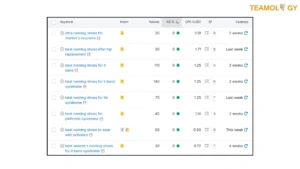As competition for broad, high-volume keywords increases only more focused strategies can actually attract qualified traffic to organization websites. Long-tail keywords specific, low-competition search phrase can offer much more conversion potential despite lower search volumes. Since these keywords better align with users’ intent, they help businesses stand out amid the noise in the digital landscape.
What are long tail keywords?
Long-tail keywords are descriptive phrases that have a niche audience. While running shoes could be a long-tail keyword, “best running shoes for marathon training” would be better. These are phrases with more specificity and user intent, and therefore really valuable for driving conversions. In 2025, the advancement in SEO tools and algorithms will make it even more straightforward to identify and rank for these precise keywords, giving businesses the leeway to refine their SEO strategy for superior results.

Long Tail Keyword Research Metrics
Step 1: How to Find Long-Tail Keywords
1. Utilize SEO Tools
You can filter keywords by competition, search volume, and user intent with platforms such as Ahrefs, SEMrush, and Moz. Most often, keywords with a moderate volume and low competition hint at hidden potential.
2. Google Autocomplete
Type in a broad keyword in the Google search bar and watch as suggested phrases pop up, based on actual user searches. Many of these suggestions expose long-tail keywords.
3. Related Searches and People Also Ask
Scroll down to the bottom of search results for related searches or use the “People Also Ask” feature for more keyword ideas.
4. Optimize for Voice Search
Voice search is increasing and therefore, conversational queries like “best eco-friendly sneakers near me” are becoming common. Focus on question-based long-tail keywords to capture this growing trend.
Step 2: Add long-tail Keyword Effectively
To rank well for long-tail keywords, the content needs to be very closely aligned with user intent. For example, if your target keyword is “best vegan skincare products for sensitive skin,” your content should be able to offer in-depth and valuable information about such products. Specific user concerns need to be addressed, unique features highlighted, and relevant questions answered. It is necessary to present high-quality content that is well-researched, comprehensive, and useful in order to engage your audience and meet their search intent.
1. Optimize On-page SEO
Incorporate long-tail keywords naturally into title tags, meta descriptions, headings, and body text. Use long-tail keyword with low competitors to rank your higher on google search engine. Moreover, crafting content without keyword stuffing, and using user-friendly and engaging tone can optimize your content for on-page SEO.
2. Leverage an FAQ Section
FAQs are also great for search-based long-tail keyword opportunities and a better user experience. Answer more specific questions and increase the chances of displaying in the featured snippets, such as “best budget laptops for students.” With this, one can get lengthy FAQs for choosing a less expensive laptop for each situation.
Step 3: Optimize for conversions
Traffic is just the first step the ultimate goal is to convert that traffic into customers or leads. Long-tail keywords can play a crucial role in optimizing for conversions.
1. Create Targeted Landing Pages
Develop landing pages that align directly with your long-tail keywords to cater to specific user intent. For example, if your keyword phrase is “best organic masala tea for weight loss,” design a page to display the best organic masala tea leaves suitable for weight loss. Use descriptions, comparison features, customer reviews, and call-to-action to help make sales or inquiring orders from the site.
All such focused pages enable people to find what they exactly seek and enhance conversion. An excellent user experience is what keeps visitors interested and pushes them to convert. Your website should be mobile-friendly, fast-loading, and easy to navigate. A clean and intuitive design with clear pathways to products or services increases the chances of conversion. Features such as a search bar, product filters, and visible CTAs increase the chances of conversion by visitor action.
2. Use Content Marketing
Long-tail keywords will form a strong foundation in your content marketing strategy. Write a blog post, tutorial, case study, or video based on particular user queries. Support these pieces of content with lead magnets such as free trials, download guides, or webinars to extract visitor information. These tools guide prospects through the sales funnel until they become loyal customers. Because you address their needs directly, this creates trust and meaningful engagement.
Step 4: Monitor, Analyze, and Optimize
SEO is an ongoing process and the work doesn’t end once your content is published. In 2025, it will be critical to regularly monitor your keyword performance and make data-driven adjustments. Use tools like Google Analytics and Google Search Console to track how well your pages rank for long-tail keywords and how visitors are interacting with your site. If a specific long-tail keyword is not doing well for you, consider changing up your content or targeting new related keywords. If a keyword is bringing in high-quality traffic, consider additional content around the same theme to build on that.
Conclusion
Long-tail keywords are an incredible opportunity for a business to target low-competition phrases and attract highly qualified traffic. You will rank better, have higher conversion rates, and be even more successful in achieving long-term SEO goals by focusing on specific intent-driven searches. By 2025, it’s clear the mastering of long-tail keyword research, implementation, and optimization will be even more critical to competitiveness in this really busy digital space. Follow these actionable steps and see your way toward long-tail keywords full-potential maximization, leading to better sight, traffic, and finally conversions on your website.


